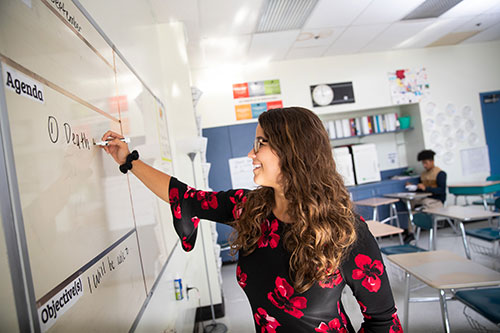As a teen in Northeastern Rhode Island, Sofia Dias noticed that although her school’s student body was diverse, the teaching staff weren’t — and neither was the reading material.
“Although it was very diverse, my school didn’t have a ton of teachers who looked like me,” Dias said. “And I loved English class, but I found I didn’t personally connect with the books we were reading.”
 Dias, who now teaches 11th-grade English at Paul Cuffee School in Providence, wished she could have read more books by authors of color in school. That wish fueled her desire to teach.
Dias, who now teaches 11th-grade English at Paul Cuffee School in Providence, wished she could have read more books by authors of color in school. That wish fueled her desire to teach.
“I really wanted to teach the kinds of books I wanted to read when I was in high school,” she said. “I wanted to have conversations about race and class with students.”
While earning her undergraduate degree in English from Salve Regina University in Newport, Dias discovered she was passionate about social justice. After graduating, she went in search of master’s programs that would equip her with the tools she’d need to make a positive impact in a classroom with students from diverse backgrounds — and she found a perfect fit with the Master of Arts in Teaching program at Brown.
“The program was really grounded in social justice and focused on supporting kids in urban schools,” she said.
Dias’ cohort was small, which allowed her to form close relationships with her fellow students and with the faculty. And the approach to advising and mentoring was personalized — so much so that Dias was in control of her own teaching journey while at Brown.
“For every single student, the teaching experience was a little bit different,” she said. “Some students chose to shadow their mentor teacher for a couple of weeks. When mine asked what I wanted to do, I said I wanted to be the students’ teacher from day one.”
But just because Dias was at the head of the classroom from the start didn’t mean she was alone. Her mentor, Laura Maxwell, helped guide her through the teaching process, sharing tips for how to keep students engaged, how to balance teaching and administrative tasks, and how to modify her teaching plan to suit the individual needs of her class.
“It was an incredible opportunity to learn and grow as a teacher,” she said. “I learned the importance of noticing every single student in your classroom and making sure they feel heard.”
Dias says the lessons she learned at Brown — both as a teacher and as a student — still inform her daily teaching practices at Paul Cuffee School. Brown’s curriculum, which focuses on serving diverse students in urban communities, provided ideal training for Dias, who now teaches mostly students of color from lower-income families.
“I really focus on celebrating aspects of their identity by diversifying the books we read and asking them to bring their poetry into the classroom,” Dias said. “I learned to do that in the MAT program.”
But Dias didn’t just learn how to set students up for academic and career success. Through the MAT program, she also learned how she could empower students to make a positive impact in their own communities.
“Giving my students tools to combat racism, prejudice and bias is important,” she said. “In English class, that could mean giving them an essay or news article that helps them make connections between the literature we’re reading and the issues that directly affect them today. I think it’s important for them to understand current events, because I really do believe that education is this incredible tool that can transform the world."